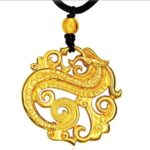 The tourmaline is a real miracle of colour. It not only comes in green, red, blue, yellow, colourless and black, but also as a multi-coloured or colour-changing gemstone or as a cat’s eye. There are, furthermore, innumerable mixtures of colour, in all nuances and depths, and some very unusual tones too. However, until recently, there were no pure yellows in the rich colour range of the ‘gemstone of the rainbow’, as this stone is also known. Most of the yellow tourmalines found thus far had a slight tinge of brown. But the tourmaline not only has many different colours; it is also good for a surprise now and then, as for example at the beginning of the 1990s, when some fantastic blue-green to turquoise tourmalines suddenly arrived on the market from a find in Paraiba, Brazil.
The tourmaline is a real miracle of colour. It not only comes in green, red, blue, yellow, colourless and black, but also as a multi-coloured or colour-changing gemstone or as a cat’s eye. There are, furthermore, innumerable mixtures of colour, in all nuances and depths, and some very unusual tones too. However, until recently, there were no pure yellows in the rich colour range of the ‘gemstone of the rainbow’, as this stone is also known. Most of the yellow tourmalines found thus far had a slight tinge of brown. But the tourmaline not only has many different colours; it is also good for a surprise now and then, as for example at the beginning of the 1990s, when some fantastic blue-green to turquoise tourmalines suddenly arrived on the market from a find in Paraiba, Brazil.
Meanwhile, this colourful gemstone has taken the world by surprise again with another new variety, and this time it is a yellow one: in southern East Africa, in Malawi, a gemstone deposit with some wonderful yellow tourmalines was discovered in the autumn of 2000. The fresh, springlike yellow of these tourmalines is clear and pure and has just a very fine hint of green. Under the trade name ‘canary’, the new tourmaline variety has now begun to circulate.
 This is a particularly interesting kind of tourmaline. It is fine traces of magnesium that are responsible for the electrifying yellow colour. Since not all the raw crystals actually show that radiant yellow when they are found, some of the stones first have to submit to a period spent in the oven at approximately 700 degrees Celsius. Without this treatment, the colour would have a slight brownish tinge. The treatment only brings about the desired result because tourmalines typically display different colours and different colour intensities in different directions. By heat treatment, the tourmaline’s second colour, in this case a light brown, is also transformed into the coveted radiant yellow. This is a kind of treatment customarily undertaken with many gemstones, the result of which is irreversible.
This is a particularly interesting kind of tourmaline. It is fine traces of magnesium that are responsible for the electrifying yellow colour. Since not all the raw crystals actually show that radiant yellow when they are found, some of the stones first have to submit to a period spent in the oven at approximately 700 degrees Celsius. Without this treatment, the colour would have a slight brownish tinge. The treatment only brings about the desired result because tourmalines typically display different colours and different colour intensities in different directions. By heat treatment, the tourmaline’s second colour, in this case a light brown, is also transformed into the coveted radiant yellow. This is a kind of treatment customarily undertaken with many gemstones, the result of which is irreversible.
Large yellow tourmalines are rare in Malawi too, the more so in view of the fact that only some 10 per cent of the yield is actually of gemstone quality at all. When cut, more than 95 per cent of the stones weigh less than one carat. However, they have wonderful wearing qualities, for like all tourmalines the canary-yellow beauties from Malawi have a good hardness of 7 to 7.5 on the Mohs scale.
 There is another speciality that distinguishes these gemstones from others, and that is their fine smell. It is an odour that the person wearing the stone will not notice, but the cutter will, while he is giving the raw crystals their final shape with his steady hand and taking great care that the fresh yellow is brought out to the best possible advantage. Experienced cutters are particularly fond of working on these gemstones, and say that these are the only gemstones that smell good.
There is another speciality that distinguishes these gemstones from others, and that is their fine smell. It is an odour that the person wearing the stone will not notice, but the cutter will, while he is giving the raw crystals their final shape with his steady hand and taking great care that the fresh yellow is brought out to the best possible advantage. Experienced cutters are particularly fond of working on these gemstones, and say that these are the only gemstones that smell good.
So why does a gemstone smell? The explanation is simple: tourmaline crystals are often embedded at the place where they are found in a black material which needs to be removed before cutting begins. One day, the owner of the gemstone mine in Malawi discovered that the unwanted black material was easier to remove if the raw crystals were first boiled in water to which lemon juice had been added. So since then, the yellow tourmaline crystals from Malawi have had not only the pleasant colour of fresh lemons, but also their fragrance. At least up to the moment when cutting starts.
















